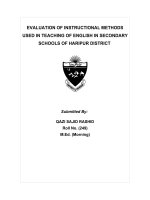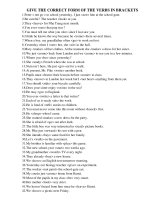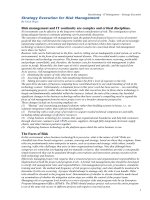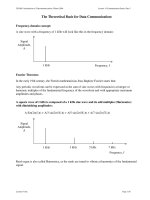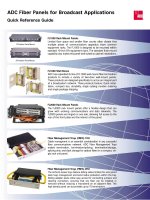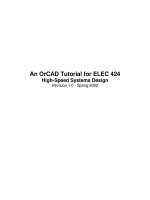Healthy Cooking for Secondary Schools pptx
Bạn đang xem bản rút gọn của tài liệu. Xem và tải ngay bản đầy đủ của tài liệu tại đây (5.26 MB, 91 trang )
Contents
Introduction
How to use the resources
Visual Lesson Structure Cards
Working Together: Discussion Cards
Recipes
Pastry Croissant Moons
Salmon Patties
Chicken Curry
Spring Rolls
Borek
Jambalaya
Bacon and Bean Pie
Wholemeal Drop Scones
Tortilla
Spicy Meatballs
Macaroni Cheese
Vegetable Samosas
What Can You Remember (1)
What Can You Remember (2)
Certicate of Achievement
Healthy Cooking
for
Secondary Schools
Sandra Mulvany
Brilliant Publications
5
Book
Published by
Brilliant Publications
Unit 10, Sparrow Hall Farm,
Edlesborough, Dunstable,
Bedfordshire, LU6 2ES
e-mail:
website: www.brilliantpublications.co.uk
Digital Edition converted and published by
Andrews UK Limited
www.andrewsuk.com
e name ‘Brilliant Publications’ and the logo are registered trade marks.
Written by Sandra Mulvany
Illustrated by Kerry Ingham
Cover design by Brilliant Publications
Photography by Brilliant Publications
© 2008 Sandra Mulvany (text);
Brilliant Publications (photography, design and layout)
e right of Sandra Mulvany to be identied as the author of this work has
been asserted by herself in accordance with the Copyright, Design and Patents
Act 1988. Healthy Cooking for Secondary Schools (Book 5) is photocopiable
from page 7 through to page 87. ese pages have the phrase ‘is page may
be photocopied for use by the purchasing institution only’ at the bottom.
ey may be photocopied by the purchasing institution or individual
teachers for classroom use only, without consent from the publisher. e
material in this book may not be reproduced in any other form or for any
other purpose without the prior permission of the publisher.of the publisher.
5
© Sandra Mulvany and Brilliant Publications Healthy Cooking for Secondary Schools (Book 5)
www.brilliantpublications.co.uk
Simple practical cooking is a fundamental life skill that all young people should be
able to master by the time they leave secondary school.
Through practical cooking, young people are empowered to make healthy choices
themselves. These choices take place all the time: when we plan our meals, when
we shop, when we store our food and when we cook it. At every stage of the
cooking process, young people need to have the knowledge to turn these choices
into informed choices.
The understanding of food, nutrition and balanced diets, safety and hygiene is most
successfully acquired through practical experiences. Through cooking and using a
wide range of skills, ingredients and recipes, young people are given the chance to
appreciate that cooking is for everyone.
Healthy Cooking for Secondary Schools (Book 5) is part of a series of fi ve books,
providing a practical cooking programme for schools, designed to foster enthusiasm
for cooking and give young people the tools to choose a healthy life. Each book
contains 12 easy-to-follow recipes.
For each recipe you will fi nd:
Skill focus for lesson –These become progressively more advanced as
you progress through the series
Theory – Providing information on where food comes from, nutrition,
balanced diet and healthy eating
Health and safety points.
Each recipe appears in two formats, so that you can choose the format best suited to
your students:
Illustrated step-by-step format
Traditional format
The step-by-step format is particularly suited to lower ability groups. The instructions
are the same in both versions, so you may use both in mixed ability classes.
Introduction
6
Healthy Cooking for Secondary Schools (Book 5) © Sandra Mulvany and Brilliant Publications
www.brilliantpublications.co.uk
How to use the Resources
All ingredients are based on two pupils sharing, and the timings will all fi t into a
double lesson of approximately 80 minutes. We recommend you use low-fat options
where possible.
Make a display using the Visual Lesson Structure Cards (pages 7–10) and pictures of
the recipe and skill to be focussed on in the lesson (to download colour photos of
the recipes, log on to www.brilliantpublications.co.uk/PAGE1028 and click on the
recipe you want).
Keep the skill, theory and health and safety point sheets to hand so that you can refer
to them when demonstrating to pupils. (The language has been kept as simple as
possible on these sheets, so you may wish to give copies to your pupils as well.)
Choose the best format of the recipe to use for each pair of children and photocopy
suffi cient copies. The illustrated versions of the recipes can be photocopied onto
either an A3 sheet (if space is an issue, fold it in half so that you view six steps at a
time), or reduced to A4 size.
If you place the recipes and other sheets in clear plastic wallets (or laminate them),
they can be used again and again.
Encourage children to gather together all the ingredients and equipment they need
before starting. They could tick things off on their copy of the recipe.
Demonstrate the recipe 2–3 steps at a time, introducing the skill, theory and health
and safety points as you progress through the recipe.
An important aspect of learning to cook is learning to work together. You may wish
to display the Discussion cards on pages 11–12 (Communicate, Share, Help, Be
pleasant) so that you can refer to these throughout the lesson.
There are assessment sheets on pages 85 and 86 that provide a fun way of testing the
practical and theoretical knowledge gained. The Certifi cate of Achievement on page
87 can either be used as an ongoing record or be given out when all the recipes in
the book have been completed.
Above all, have fun and enjoy cooking!
This page may be photocopied by the purchasing institution only.
7
© Sandra Mulvany and Brilliant Publications Healthy Cooking for Secondary Schools (Book 5)
www.brilliantpublications.co.uk
Today We are Making
Today We are Learning
1
2
8
Healthy Cooking for Secondary Schools (Book 5) © Sandra Mulvany and Brilliant Publications
www.brilliantpublications.co.uk
This page may be photocopied by the purchasing institution only.
Wash Hands and Prepare
Read Recipe
3
4
This page may be photocopied by the purchasing institution only.
9
© Sandra Mulvany and Brilliant Publications Healthy Cooking for Secondary Schools (Book 5)
www.brilliantpublications.co.uk
Clear Away
Cook
5
6
10
Healthy Cooking for Secondary Schools (Book 5) © Sandra Mulvany and Brilliant Publications
www.brilliantpublications.co.uk
This page may be photocopied by the purchasing institution only.
We Have Learnt
Tasting
8
7
This page may be photocopied by the purchasing institution only.
11
© Sandra Mulvany and Brilliant Publications Healthy Cooking for Secondary Schools (Book 5)
www.brilliantpublications.co.uk
Good sharing follows on from good communicating. If you have
communicated well, you will have reached a fair decision about sharing.
Sharing works best when it has been done fairly and everyone is happy.
Sharing is particularly diffi cult if it involves doing something really exciting or
really boring. You have to imagine that the other person feels very much like
yourself. This can be hard to imagine, but it is an important lesson to learn.
Sharing is a lot easier when you talk together about things.
Communicate
It is vital to have good communication in the kitchen. If you are working with
a partner, it is important to say what you are doing and to agree on who does
what. You have to talk about what you would like to do and listen to what your
partner wants to do. Then you have to work out a way to make it fair for both
of you. You can only come to an agreement if you talk together!
You should also let others know if there are any dangers, such as you opening
the oven or if water has been spilt on the fl oor. Talking is absolutely key to
good cooking habits. The better you are at communicating, the better you are
at cooking in a school kitchen.
Share
12
Healthy Cooking for Secondary Schools (Book 5) © Sandra Mulvany and Brilliant Publications
www.brilliantpublications.co.uk
This page may be photocopied by the purchasing institution only.
Help
Be pleasant
It is important to be able to help others, but it is also important to accept help
from others. Help is a two-way thing. If you are offering your help to someone
else, it is important that you choose your words carefully. Be kind in giving
your help, as it can be hard to accept help given with harsh words. If you have
communicated well, you will be able to help each other well. If you are very
capable, offer your help kindly, but also let others help you in return, even if it is
to do with something you feel you might already know about.
It is, in fact, very simple to be pleasant. Look at and listen to the person you are
working with and notice something he or she does well. Then say something
pleasant about that. You will soon discover that the more pleasant you are to
people, the more pleasant they are back to you. You can also do something
pleasant, like smile at a person or pat someone kindly on the back. Don’t just
wait for someone to be pleasant to you; try to be the fi rst one to say or do
something pleasant.
This page may be photocopied by the purchasing institution only.
13
© Sandra Mulvany and Brilliant Publications Healthy Cooking for Secondary Schools (Book 5)
www.brilliantpublications.co.uk
Pastry Croissant
Moons
14
Healthy Cooking for Secondary Schools (Book 5) © Sandra Mulvany and Brilliant Publications
www.brilliantpublications.co.uk
This page may be photocopied by the purchasing institution only.
It is best to watch a demonstration of someone rolling a croissant. You will see that
the dough is fi rst rolled out into a circle and cut in quarters. Next, each quarter
is rolled up, starting at the wide end and rolling into a point. Then the rolled-
up dough is shaped into a crescent shape and the end or tip is tucked under the
dough, so that it doesn’t come undone during baking.
How to Roll a Croissant
This page may be photocopied by the purchasing institution only.
15
© Sandra Mulvany and Brilliant Publications Healthy Cooking for Secondary Schools (Book 5)
www.brilliantpublications.co.uk
Foods Contain More Than
One Type of Nutrient
Always be aware of the smells in a kitchen, particularly when you have something
in the oven. You can generally smell when the food in the oven is ready. You can
also smell when it is burning. The more you bake, the more you will be able to
understand the smells you smell.
When we begin to learn about nutrients, we tend to generalize to make it simple.
We might say that protein is found in meat and eggs, carbohydrates are found in
bread and pasta and vitamins are found in vegetables. This is all true. However,
most foods contain more than just one type of nutrient. When we say that eggs
have protein in them, this is true, but they also have other nutrients in them,
including vitamins A, D and E, B vitamins, iron and calcium. When we talk
about nutrients in bread, don’t forget that bread fl our contains protein in addition
to carbohydrates. On top of that, bread also contains yeast, margarine and
sometimes milk, all of which have their own nutrients in them.
Be Aware of Smells
16
Healthy Cooking for Secondary Schools (Book 5) © Sandra Mulvany and Brilliant Publications
www.brilliantpublications.co.uk
This page may be photocopied by the purchasing institution only.
Pastry Croissant Moons
1. Put the oven on 200˚C.
2. Mix fl ours; rub in margarine.
3. Add baking powder and
cinnamon and mix it.
4. Crack the egg into a cup and
whisk it.
5. Add the milk to the cup and
whisk.
6. Pour the egg and milk
mixture into the bowl. Mix to
form a dough.
Ingredients: 100g wholemeal fl our 25g plain fl our
50g margarine 1 tsp baking powder 1 tsp cinnamon
1 egg 2 dsp milk
This page may be photocopied by the purchasing institution only.
17
© Sandra Mulvany and Brilliant Publications Healthy Cooking for Secondary Schools (Book 5)
www.brilliantpublications.co.uk
7. Divide the dough in two.
8. Roll each piece into a round
shape.
9. Divide into 4 with a knife.
10. Roll up each part and put on
a baking tray.
11. Brush with milk.
12. Bake in the oven for 10–15
minutes.
Pastry Croissant Moons (cont.)
Equipment: Mixing bowl Mixing spoon Knife
Scales Rolling pin Baking tray Measuring spoons
Cup Whisk/fork Flour dredger Brush
18
Healthy Cooking for Secondary Schools (Book 5) © Sandra Mulvany and Brilliant Publications
www.brilliantpublications.co.uk
This page may be photocopied by the purchasing institution only.
Pastry Croissant Moons
Ingredients: Equipment:
100g wholemeal fl our Mixing bowl Brush
25g plain fl our Mixing spoon Cup
50g margarine Knife Whisk/fork
1 tsp baking powder Scales Flour dredger
1 tsp cinnamon Rolling pin
1 egg Baking tray
2 dsp milk Measuring spoons
Instructions:
1. Put the oven on 200˚C.
2. Mix fl ours; rub in margarine.
3. Add baking powder and cinnamon and mix it.
4. Crack the egg into a cup and whisk it.
5. Add the milk to the cup and whisk.
6. Pour the egg and milk mixture into the bowl. Mix to form a dough.
7. Divide the dough in two.
8. Roll each piece into a round shape.
9. Divide into 4 with a knife.
10. Roll up each part and put on a baking tray.
11. Brush with milk.
12. Bake in the oven for 10–15 minutes.
This page may be photocopied by the purchasing institution only.
19
© Sandra Mulvany and Brilliant Publications Healthy Cooking for Secondary Schools (Book 5)
www.brilliantpublications.co.uk
Salmon Patties
20
Healthy Cooking for Secondary Schools (Book 5) © Sandra Mulvany and Brilliant Publications
www.brilliantpublications.co.uk
This page may be photocopied by the purchasing institution only.
How to Coat Fish in Flour
Many fi sh recipes use breadcrumbs as a coating. Often you will be asked to coat
the fi sh in egg fi rst and then in breadcrumbs. Salmon patties are very moist from
the outset, so we do not need to coat them in egg fi rst. You can choose whether
to coat the patties in breadcrumbs or just in plain fl our. In either case, you put a
little fl our or breadcrumbs on a plate and then you simply turn the patty over in it
several times to coat it. The fl our will help to make the patty more solid and stick
together better.
This page may be photocopied by the purchasing institution only.
21
© Sandra Mulvany and Brilliant Publications Healthy Cooking for Secondary Schools (Book 5)
www.brilliantpublications.co.uk
What is Omega 3 Good for?
Keep cooked food and raw meat separate.
Omega 3 is found in all fi sh. The main source for omega 3 is found in oily
fi sh such as tuna, sardines, salmon and mackerel, but is also present in soya,
pumpkin seeds, walnuts and leafy-green vegetables in small quantities. Omega 3
is a type of fat, but it is a good fat which has many health benefi ts and therefore
it is a fat we need a lot of. One major benefi t is that it is very good for the heart.
Scientifi c studies also point to the fact that Omega 3 is very good for the brain
and helps to relieve anxiety, depression and ADHD. It is also a natural anti-
infl ammatory.
This recipe calls for tinned salmon. However, you can also use fresh salmon,
bought in most supermarkets. If you bought fresh salmon you would need to
keep it separate from the cooked foods. We need to keep cooked food and raw
meat separate. This is because the raw meat, and its juices can contaminate any
cooked food. Always use separate equipment for raw meat and always keep raw
meat separate from other food in the fridge, in your shopping trolley and in your
shopping bags.
Separate Cooked and Raw
Meats
22
Healthy Cooking for Secondary Schools (Book 5) © Sandra Mulvany and Brilliant Publications
www.brilliantpublications.co.uk
This page may be photocopied by the purchasing institution only.
1. Boil the potatoes and drain
when ready.
2. Mash potatoes in a bowl.
3. Crack an egg into a cup, whisk
and add to bowl.
4. Add fl our to bowl and mash.
5. Slice olives and mix into
mixture.
6. Cut chives with a pair of
scissors and mix into mixture.
Salmon Patties
Ingredients:
1 tin of salmon 200g potatoes 2 tbsp chives
1 tsp plain fl our 6 pitted black olives 1 egg
1 tbsp olive oil
This page may be photocopied by the purchasing institution only.
23
© Sandra Mulvany and Brilliant Publications Healthy Cooking for Secondary Schools (Book 5)
www.brilliantpublications.co.uk
7. Open tin of salmon and drain
in a sieve.
8. Mix salmon fl akes into
mixture.
9. Lightly fl our your hands and
form mixture into 4 patties.
10. Coat each patty in fl our.
11. Heat olive oil on a frying pan.
12. Fry patties for 3 minutes on
each side or until golden.
Salmon Patties (cont.)
Equipment:
Saucepan Plate Colander Frying pan Sharp knife
Turner Cup Sieve Potato masher Whisk/fork Teaspoon
Chopping board Scissors Mixing bowl Tin opener
24
Healthy Cooking for Secondary Schools (Book 5) © Sandra Mulvany and Brilliant Publications
www.brilliantpublications.co.uk
This page may be photocopied by the purchasing institution only.
Salmon Patties
Ingredients: Equipment:
1 tin of salmon Saucepan Potato masher
200g potatoes Plate Whisk/fork
2 tbsp chives Colander Teaspoon
6 pitted black olives Frying pan Chopping board
1 egg Sharp knife Scissors
1 tsp plain fl our Turner Mixing bowl
1 tbsp olive oil Cup Tin opener
Sieve
Instructions:
1. Boil the potatoes and drain when ready.
2. Mash potatoes in a bowl.
3. Crack an egg into a cup, whisk and add to bowl.
4. Add fl our to bowl and mash.
5. Slice olives and mix into mixture.
6. Cut chives with a pair of scissors and mix into mixture.
7. Open tin of salmon and drain in a sieve.
8. Mix salmon fl akes into mixture.
9. Lightly fl our your hands and form mixture into 4 patties.
10. Coat each patty in fl our.
11. Heat olive oil on a frying pan.
12. Fry patties for 3 minutes on each side or until golden.
This page may be photocopied by the purchasing institution only.
25
© Sandra Mulvany and Brilliant Publications Healthy Cooking for Secondary Schools (Book 5)
www.brilliantpublications.co.uk
Chicken Curry
